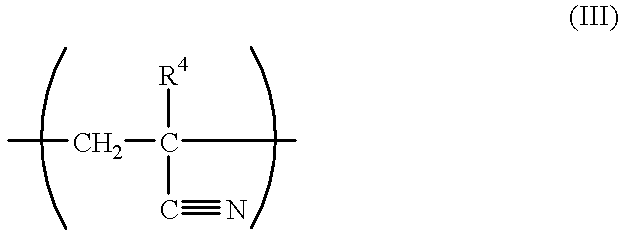Chemical amplifying type positive resist composition
- Summary
- Abstract
- Description
- Claims
- Application Information
AI Technical Summary
Benefits of technology
Problems solved by technology
Method used
Image
Examples
synthesis example 1
Resin Synthesis Example 1
Synthesis of Resin A
2-Methyl-2-adamantyl methacrylate, 3-hydroxy-1-adamantyl methacrylate and .alpha.-methacryloyloxy-.gamma.-butyrolactone were charged in a mole ratio of 5:2.5:2.5 (20.0 g:10.1 g:7.8 g), respectively. Then, methyl isobutyl ketone was added in an amount of 2 weight times based on the total amount of monomers to prepare a solution. As an initiator, azobisisobutyronitrile was added thereto in an amount of 2 mol % based on the total amount of monomers, followed by heating at 85.degree. C. for about 8 hours. Thereafter, the operation of pouring the reaction solution into a large amount of heptane to cause precipitation was repeated 3 times, thus the solution was purified. As a result, a copolymer represented by the following formula, and having a composition mole ratio of each unit of 50:25:25, and having a weight-average molecular weight of about 4,500 was obtained. The resulting copolymer is referred to as a resin A. ##STR10##
synthesis example 2
Resin Synthesis Example 2
Synthesis of Resin B
2-Methyl-2-adamantyl methacrylate, methacrylonitrile and maleic anhydride were charged in a mole ratio of 5:2.5:2.5 (20.0 g:3.1 g:4.5 g), respectively. Then, tetrahydrofuran was added in an amount of 2 weight times based on the total amount of monomers to prepare a solution. As an initiator, azobisisobutyronitrile was added thereto in an amount of 2 mol % based on the total amount of monomers, followed by heating at 60.degree. C. for about 12 hours. Thereafter, the operation of pouring the reaction solution into a large amount of heptane to cause precipitation was repeated 3 times, thus the solution was purified. As a result, a copolymer represented by the following formula, and having a composition mole ratio of each unit of 50:25:25, and having a weight-average molecular weight of about 8,000 was obtained. The resulting copolymer is referred to as resin B. ##STR11##
synthesis example 2-2
Resin Synthesis Example 2-2
Similarly, 2-methyl-2-adamantyl methacrylate, methacrylonitrile and .alpha.-methacryloyloxy-.gamma.-butyrolactone are copolymerized to give a ternary copolymer having their respective polymerization units.
PUM
| Property | Measurement | Unit |
|---|---|---|
| Temperature | aaaaa | aaaaa |
| Temperature | aaaaa | aaaaa |
| Temperature | aaaaa | aaaaa |
Abstract
Description
Claims
Application Information
 Login to View More
Login to View More - R&D
- Intellectual Property
- Life Sciences
- Materials
- Tech Scout
- Unparalleled Data Quality
- Higher Quality Content
- 60% Fewer Hallucinations
Browse by: Latest US Patents, China's latest patents, Technical Efficacy Thesaurus, Application Domain, Technology Topic, Popular Technical Reports.
© 2025 PatSnap. All rights reserved.Legal|Privacy policy|Modern Slavery Act Transparency Statement|Sitemap|About US| Contact US: help@patsnap.com



